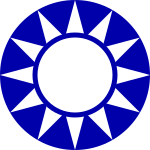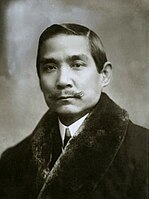Xingzhonghui
|
興 中 會 Xīngzhōnghuì Society for the Resurrection of China |
|
|---|---|

|
|
| Party leader | Yang Quyun |
| founding | November 24, 1894 in Honolulu |
| resolution | August 20, 1905 |
| Headquarters | Hong Kong , 13 Staunton Street |
The Xingzhonghui , Society for the Resurrection of China, was a political party of opposition Chinese in the late 19th and early 20th centuries.
history
The Xingzhonghui was founded on November 24, 1894 by Sun Yat-sen to end the foreign rule of the Manchurian imperial house of the Qing , to establish a republic and to counter the weakening of China by imperialist states. Xingzhonghui was founded during the First Sino-Japanese War , after a series of Chinese military defeats exposed both corruption and incompetence within the imperial government.
Other revolutionary republican parties existed even before the Xingzhonghui was founded, such as the Huaxinghui in Hunan , the Guangfuhui in Jiangsu , Zhejiang and Shanghai , the Gongjinhui on the upper reaches of the Changjiang in Sichuan , the Furenwen in Hong Kong , the Yiwenhui and the Hanzhuduilihui in Fujian , Gongchanghui in Sichuan, Yizhihui in Jiangxi , Yuewanghui in Anhui, and Qunzhihui in Guangdong .
Since Sun was in exile during this time, the company was founded in Honolulu , the capital of the short-lived Republic of Hawaii . Its members were initially largely uneducated Cantonese from Hawaii and Hong Kong. In the eleven years of its existence, the Xingzhonghui only had 500 members.
The persons admitted to the secret society had to commit themselves on oath to the following goals: "Expulsion of the Tatar barbarians, revival of China, formation of a united government." (驱逐 鞑 虏, 恢复 中华, 建立 合众 政府)
When Sun Yat-sen returned to Hong Kong in early 1895, he met again with Yang Quyun (楊 衢 雲), the president of the Furen Educational Association (輔仁 文 社), whom he had already met in 1891. Both wanted to take advantage of the discomfort in the Chinese population that had resulted from the Sino-Japanese War. On February 18, 1895, the Furen Educational Association was incorporated into the Xingzhonghui, which changed the membership. Yang and Sun became the Society's President and Secretary, respectively. They disguised their activities in Hong Kong under the guise of a company called the "Qianheng Club" (乾 亨 行 Qianhengxing).
| Board | |
|---|---|
 
|
|
| Party leader | Yang Quyun, Chairman Sun Yat-sen, Secretary |
In October 1895, the Xingzhonghui planned an uprising in Guangzhou , with Yang leading the uprising from Hong Kong because member Li Jitang (李紀堂) had provided resources and training places there. However, the plans leaked, and 72 members, including 27-year-old Lu Haodong (陸皓東), a friend of Sun Yat-sen's school days, were arrested and executed by the Qing government . Under pressure from the Qing government in mainland China, the British colonial authorities in Hong Kong forced Yang and Sun Yat-sen to leave the country and banned them from entering Hong Kong for five years. Yang therefore traveled via Singapore to Johannesburg in South Africa and later to Japan. He stayed there from 1896 to 1899 to promote the Xingzhonghui and to spread their ideas. Another uprising in Guangdong in 1900 failed. Although Sun Yat-sen had become world famous for being kidnapped and abducted to the Chinese embassy in London in 1896, the group lost its clout after the two unsuccessful uprisings in 1895 and 1900, so that it united with other associations to form the Tongmenghui , from which the Kuomintang (KMT) arose after the founding of the Republic of China . The KMT therefore recognizes the Xingzhonghui founding date as that of its own party.
The Xingzhonghui emblem, which was adopted by the KMT, was designed by Lu Haodong and presented in Honolulu.
literature
- Marie-Claire Bergère: Sun Yat-sen . Stanford University Press, Stanford / California, 1998, ISBN 978-0-804740111
- Haruhiro Fukui: Political Parties of Asia and the Pacific. Vol. 1. Greenwood Press, Westport / Connecticut-London, 1985
- Dieter Kuhn: The Republic of China 1912 - 1949. Draft for a political event history . 3rd edition, Edition Forum, Heidelberg, 2007
- Harold Zvi Schiffrin: Zhongguo Tongmeng Hui , In: Fukui, vol. 1, p. 267 ff.
- Thomas Weyrauch: China's Democratic Traditions from the 19th Century to the Present in Taiwan . Longtai, Heuchelheim 2014, ISBN 978-3-938946-24-4
- Thomas Weyrauch: The party landscape in East Asia . Longtai, Heuchelheim 2018, ISBN 978-3-938946-27-5
- Thomas Weyrauch: Political Lexicon East Asia . Longtai, Heuchelheim 2019, ISBN 978-3-938946-28-2
Individual evidence
- ↑ Hong Kong Antiquities and Monuments Office
- ↑ Thomas Weyrauch: The party landscape of East Asia , p. 133.
- ↑ Thomas Weyrauch: Politisches Lexikon Ostasiens , p. 245.
- ↑ Dieter Kuhn: The Republic of China , p. 48 f.
- ↑ Thomas Weyrauch: Chinas Democratic Traditions , p. 37.
- ↑ Harold Zvi Shipwoman: Zhongguo Tongmeng Hui . In: Fukui, Vol. 1, p. 267.
- ↑ 刘 蜀 永: 从 香港 史 看 西方 对 近代 中国 社会 的 影响 (Liu Shuyong: The influence of the West on modern Chinese society from the perspective of Hong Kong's history) ( online )
- ↑ Harold Zvi Schiffrin: Zhongguo Tongmeng Hui, In: Fukui, Political Parties of Asia and the Pacific, Vol. 1, p. 267; 刘 蜀 永: 从 香港 史 看 西方 对 近代 中国 社会 的 影响 (Liu Shuyong: The influence of the West on modern Chinese society from the perspective of Hong Kong's history) ( online )
- ^ Marie-Claire Bergère: Sun Yat-sen , p. 147.